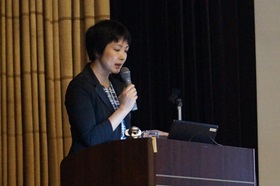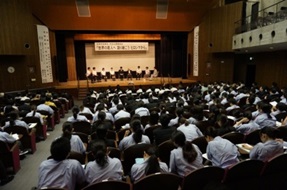- News
RERF scientist delivers keynote lecture at Hiroshima City Medical Association event, giving students encouragement

Dr. Atsuko Sadakane, delivering keynote lecture

Roundtable discussion between physician who experienced the atomic bombing and high school students, with junior and high school students from Minami-soma city, Fukushima prefecture
A public lecture hosted by the Hiroshima City Medical Association was held on July 30, 2017, at the
Association’s hall located in Kanon-honmachi, Nishi-ku, Hiroshima, with the theme “Passing on Hiroshima’s story to young people around the world.” One of RERF’s research scientists served as a lecturer at the event.
Dr. Atsuko Sadakane, Senior Research Scientist, Department of Epidemiology, Hiroshima RERF, delivered a keynote lecture titled “Long-term health effects of A-bomb radiation.” Dr. Sadakane explained: that A-bomb radiation is classified into initial radiation and residual radiation (induced radiation and radioactive fallout); that geographic differences between Hiroshima and Nagasaki led to disparities in A-bomb radiation exposure conditions; details of acute symptoms; and that cancer risks among A-bomb survivors are higher than those who were not exposed even more than 70 years after the A-bombings. Dr. Sadakane also stated that cognitive disability and microcephaly were observed among those exposed in utero and that, despite there being no evidence of genetic effects from parental radiation exposure in A-bomb survivors’ children, observation of this population should be continued.
Beyond explanation of the aforementioned scientific findings, Dr. Sadakane stated that “I am neither from Hiroshima nor Nagasaki. To be honest, until I came to Hiroshima to live, I thought that the atomic bombings were a thing of the past.” She continued, “I also felt that the consciousness regarding the atomic bombings and peace among residents in regions besides Hiroshima and Nagasaki is not very high. However, it was not until I came to Hiroshima that I understood that the A-bombings were not just a thing of the past but a clear and present issue.” She concluded her keynote lecture by speaking enthusiastically to the large number of students: “When entering the world of work as professionals, it is important to convey the Hiroshima experience to people. Learn all you can to add to the existing knowledge about the atomic bombings, so that radiation health effects can be assessed accurately.”
The event, hosted by the Association-which is mainly comprised of member physicians who are second-generation A-bomb survivors in Hiroshima-started in 2015 at the time of the 70th anniversary of the atomic bombings of Hiroshima and Nagasaki, with the aim of passing on A-bombing experiences and wishes for peace to succeeding generations. This year’s was the third such event. This 2017 event included Dr. Sadakane’s aforementioned keynote lecture, a lecture on the remembrances of a physician who experienced the atomic bombing and his roundtable discussion with high school students, as well as a musical interlude performed by the music club of Hiroshima Jogakuin Senior High School and volunteers from Hiroshima Gakuin Senior High School. About 300 people attended the public lecture, including students and members of the general public.
